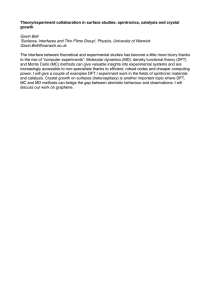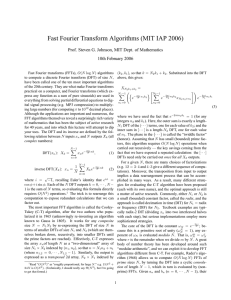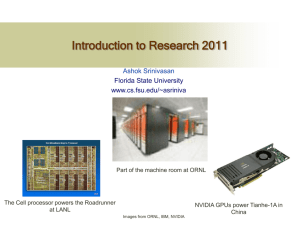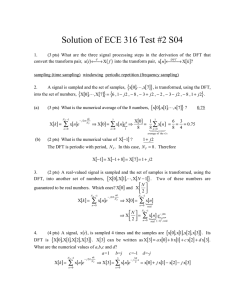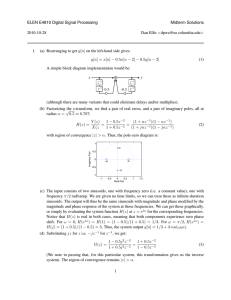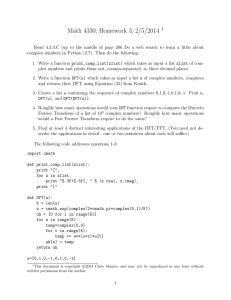Small Discrete Fourier Transforms on GPUs
advertisement
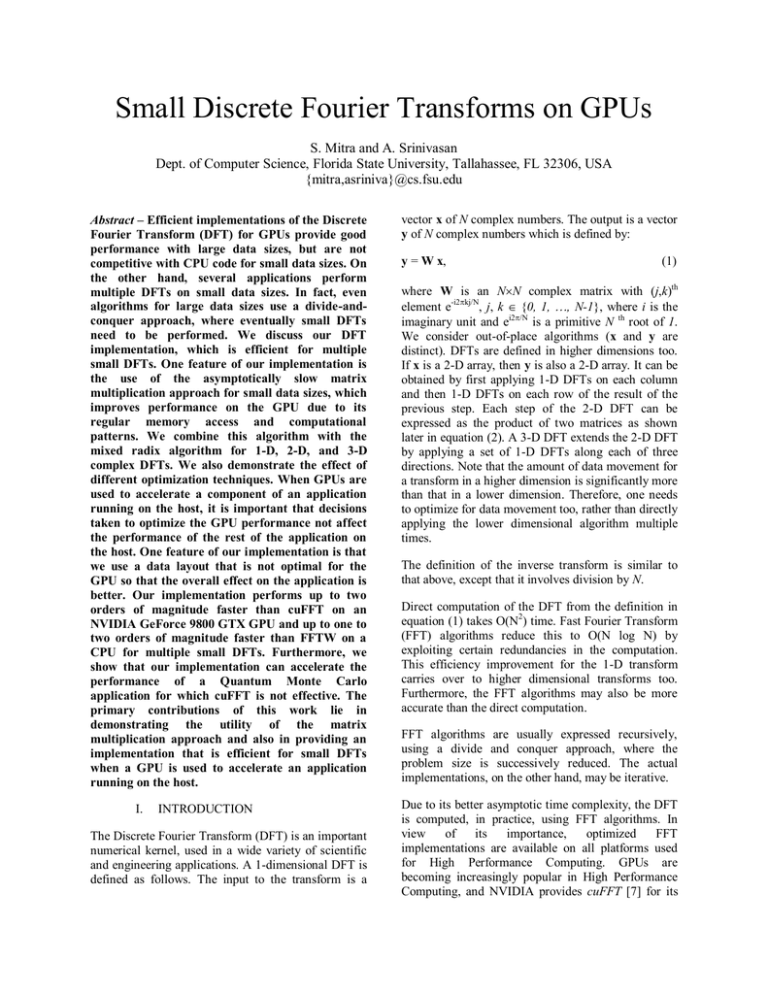
Small Discrete Fourier Transforms on GPUs
S. Mitra and A. Srinivasan
Dept. of Computer Science, Florida State University, Tallahassee, FL 32306, USA
{mitra,asriniva}@cs.fsu.edu
Abstract – Efficient implementations of the Discrete
Fourier Transform (DFT) for GPUs provide good
performance with large data sizes, but are not
competitive with CPU code for small data sizes. On
the other hand, several applications perform
multiple DFTs on small data sizes. In fact, even
algorithms for large data sizes use a divide-andconquer approach, where eventually small DFTs
need to be performed. We discuss our DFT
implementation, which is efficient for multiple
small DFTs. One feature of our implementation is
the use of the asymptotically slow matrix
multiplication approach for small data sizes, which
improves performance on the GPU due to its
regular memory access and computational
patterns. We combine this algorithm with the
mixed radix algorithm for 1-D, 2-D, and 3-D
complex DFTs. We also demonstrate the effect of
different optimization techniques. When GPUs are
used to accelerate a component of an application
running on the host, it is important that decisions
taken to optimize the GPU performance not affect
the performance of the rest of the application on
the host. One feature of our implementation is that
we use a data layout that is not optimal for the
GPU so that the overall effect on the application is
better. Our implementation performs up to two
orders of magnitude faster than cuFFT on an
NVIDIA GeForce 9800 GTX GPU and up to one to
two orders of magnitude faster than FFTW on a
CPU for multiple small DFTs. Furthermore, we
show that our implementation can accelerate the
performance of a Quantum Monte Carlo
application for which cuFFT is not effective. The
primary contributions of this work lie in
demonstrating the utility of the matrix
multiplication approach and also in providing an
implementation that is efficient for small DFTs
when a GPU is used to accelerate an application
running on the host.
I.
INTRODUCTION
The Discrete Fourier Transform (DFT) is an important
numerical kernel, used in a wide variety of scientific
and engineering applications. A 1-dimensional DFT is
defined as follows. The input to the transform is a
vector x of N complex numbers. The output is a vector
y of N complex numbers which is defined by:
y = W x,
(1)
where W is an NN complex matrix with (j,k)th
element e-i2kj/N, j, k {0, 1, , N-1}, where i is the
imaginary unit and ei2/N is a primitive N th root of 1.
We consider out-of-place algorithms (x and y are
distinct). DFTs are defined in higher dimensions too.
If x is a 2-D array, then y is also a 2-D array. It can be
obtained by first applying 1-D DFTs on each column
and then 1-D DFTs on each row of the result of the
previous step. Each step of the 2-D DFT can be
expressed as the product of two matrices as shown
later in equation (2). A 3-D DFT extends the 2-D DFT
by applying a set of 1-D DFTs along each of three
directions. Note that the amount of data movement for
a transform in a higher dimension is significantly more
than that in a lower dimension. Therefore, one needs
to optimize for data movement too, rather than directly
applying the lower dimensional algorithm multiple
times.
The definition of the inverse transform is similar to
that above, except that it involves division by N.
Direct computation of the DFT from the definition in
equation (1) takes O(N2) time. Fast Fourier Transform
(FFT) algorithms reduce this to O(N log N) by
exploiting certain redundancies in the computation.
This efficiency improvement for the 1-D transform
carries over to higher dimensional transforms too.
Furthermore, the FFT algorithms may also be more
accurate than the direct computation.
FFT algorithms are usually expressed recursively,
using a divide and conquer approach, where the
problem size is successively reduced. The actual
implementations, on the other hand, may be iterative.
Due to its better asymptotic time complexity, the DFT
is computed, in practice, using FFT algorithms. In
view
of
its
importance,
optimized
FFT
implementations are available on all platforms used
for High Performance Computing. GPUs are
becoming increasingly popular in High Performance
Computing, and NVIDIA provides cuFFT [7] for its
platform. Other works too report implementations
optimized to take advantage of the architectural
features of GPUs. We summarize such related work on
FFTs in section II, and describe relevant GPU features
in section III.
The above implementations provide tremendous
speedup over CPU for large data. However, for small
data, they are not competitive with CPUs. On the other
hand, many important applications require the use of
small DFTs, such as in certain applications in quantum
mechanics [12], finance [8], etc. In fact, the first
application served as the motivation for this work.
Even the FFT algorithms break up the problem, at a
certain stage, into small enough pieces that an efficient
algorithm for small DFTs will lead to better
performance.
The basic idea behind our approach, explained further
in section IV, is the use of matrix multiplication for
small DFTs. Even though the asymptotic
computational cost is higher than that of FFTs, it has
the advantages of regular memory access and
computational patterns. When the data size is not
small enough to make it effective, it can be combined
with an FFT algorithm in order to improve
performance. In particular, we combine it with the
mixed-radix algorithm. We explain details of the
optimizations performed with our implementation in
section V, and compare it against cuFFT on a GPU
and FFTW [6] on a CPU, in section VI. We show that
we can get up to two orders of magnitude
improvement in performance over cuFFT and up to
one to two orders of magnitude improvement over
FFTW for multiple small DFTs in higher dimensions.
We also show that our implementation can improve
the performance of a Quantum Monte Carlo
application, which cuFFT could not improve.
The results of our work will enable applications
needing several small DFTs to make effective use of
GPUs. Developers of FFT implementations can also
use our implementation in the sub-problems of their
computations, in order to improve their performance
further. It will also be worth studying if this approach
can be used on other architectures too.
II. RELATED WORK
A large body of research exists on FFT algorithms and
their implementations on various architectures. The
modern use of FFTs dates to the Cooley-Tukey
algorithm [13]. It is based on the observation that the
matrix W of equation (1) contains only N distinct
entries for an FFT of size N. They used a divide and
conquer approach to reduce the time complexity to
O(N log N). Several variants of this approach were
then introduced by others. Pease [14] introduced a
tensor-product based algorithm. This approach is more
effective for vectorization. Sorensen and Burrus have
compiled a database of efficient FFT algorithms [3].
Van Loan [4] provides a matrix-based interpretation of
different FFT variants.
For the GPU, Nakuda et al. have reported that through
effective usage of on-chip shared memory, optimized
usage of threads and registers and avoidance of low
speed stride memory access, their 3D FFT kernel
could achieve speeds up to 84 GFlops/card for power
of 2 FFTs and up to sizes 2563 [5].
Govindaraju et al. [1] have implemented 1-D and 2-D
complex power-of-two and non-power-of-two FFTs.
They obtain improvement by factors of 2-4 over
cuFFT for large data sizes. They have also considered
small data sizes. For a single DFT, the GPU
implementation is much slower than a CPU
implementation. However, with a large number of
independent DFTs (they have considered 223/N
independent DFTs of size N each in 1-D), they obtain
substantial performance improvement.
Apart from the use of matrix-multiplication, one
important difference between our approach and that of
[1] is that many of our algorithmic choices are dictated
by the constraints imposed by applications of interest
to us. For example, [1] assumes that data resides on
the GPU DRAM. We, on the other hand, have
considered both cases, data residing on the host and
data residing on the GPU DRAM. We need to
consider the former, because it will enable an FFTintensive application to accelerate the computation by
just replacing their FFT calls with that from our
implementation. On the other hand, if the application
developer has ported much of their computation to the
GPU, then one can assume that the data is present on
the GPU DRAM, and then use the corresponding GPU
implementation, which saves on the data transfer
overhead.
We have also considered 3-D DFTs, because
applications of interest to us require these. We have
also optimized our implementations so that they
outperform CPU implementations with even a small
number of DFTs, because applications that we have
analyzed generate approximately 1-100 independent
DFTs typically. In contrast, the results of [1] assume
100,000 – 1,000,000 independent DFTs for small data
sizes.
We have also used constraints imposed by the
application to avoid certain optimizations. For
example, CPU applications often use an array of
complexes, which makes better use of cache. This can
cause inefficient use of shared memory banks on the
GPU. GPU implementations, such as [1], use two
distinct arrays to avoid this problem. However, this
will require the application to change its data structure
on the CPU, requiring substantial programming effort
by the application developer, and also accepting the
loss in performance of the CPU portion of the code.
Alternatively, the DFT routine can convert the data
layouts, compute, and reconvert it, which incurs
additional overhead. Tests on small DFTs in the range
4-24, 42-242, and 43-243 in the 1-D, 2-D, and 3-D cases
respectively show that the conversion time is typically
larger than the DFT time when several simultaneous
DFTs are computed, as we show in tables 1 and 2
below for the 1-D and 2-D cases. We have, therefore,
used an array of complexes, even though we could
have obtained better performance on the GPU by
changing the data structure. If an entire application has
been ported to the GPU, then it will be preferable to
use two arrays of real to store the complex numbers on
the GPU. For example, [11] has performed a rewrite of
essentially an entire Quantum Monte Carlo
application, involving over a hundred kernels, to the
GPU. But FFT does not account for a large fraction of
time there, unlike with the type of Quantum Monte
Carlo application that we consider here.
N
DFT computation time on
device
Time: µs/DFT
Conversion time on host
Time: µs/DFT
4
0.021
0.069
8
0.029
0.126
12
0.036
0.185
16
0.042
0.238
20
0.07
0.285
24
0.076
0.335
Table 1: DFT computation time per DFT vs data layout
conversion time for 8192 1-D DFTs of size N.
N
DFT computation time
on device
Time: µs/DFT
Conversion time on host
Time: µs/DFT
4
0.043
0.252
8
0.214
0.710
12
0.55
1.51
16
1.14
2.620
20
1.96
4.05
24
3.19
5.81
Table 2: DFT computation time per DFT vs data layout
conversion time for 8192 2-D DFTs of size NxN.
III. GPU ARCHITECTURE
We have implemented our code using the CUDA
programming framework and run it on two different
NVIDIA GPUs. The results presented are those on a
GeForce 9800 GTX. We summarize its architectural
features below [2]. Other GPUs have similar features.
The
above
GPU contains
16
Streaming
Multiprocessors (SM) that perform computation and
500 MB of DRAM memory to store global data,
accessible by all the SMs and the host CPU. Each SM
contains 8K 32-bit registers and 16KB shared
memory. Each SM also contains a cache to store
constant data (and also for texture data, which we
don't use). Each SM can run up to 768 threads
simultaneously.
In the CUDA framework, a GPU can be used to
accelerate a process running on the host in the
following manner. The process running on the host
copies relevant data to the GPU and then calls a
CUDA kernel. Once the kernel completes, its output
data may be copied back to the host memory. The
kernel call causes the creation of a number of threads,
which are partitioned into blocks. Threads of the same
block run on one SM and multiple blocks may be
mapped to the same SM if sufficient resources are
available. Threads within a block can synchronize
efficiently and have access to the same shared
memory. Threads on different blocks cannot
synchronize safely, in a general situation. If such
synchronization is needed, then it has to be
accomplished by multiple kernel calls occurring in
sequence, which will incur over ten micro-seconds of
overhead. In contrast, synchronization within a block
is supported by hardware.
The threads within a block are partitioned into groups
of 32, called warps. The scheduler schedules threads
for execution at the granularity of warps [1]. In any
instance, all threads in a warp need to execute the
same instruction, except that some threads may not
execute anything. Consequently, there is a
performance penalty if threads within a warp diverge
on a branch.
Access to DRAM incurs a latency of hundreds of
clock cycles. This latency can be hidden through
simultaneous multi-threading (single instruction
multiple threads, in particular); when one warp is
stalled on data, another warp can be scheduled for
execution. There is no context switch penalty. DRAM
latency can also be reduced by using shared memory
for data that is used multiple times. Access to shared
memory has latency of one clock cycle.
The exact details of the memory access patterns also
influence performance. For example, accesses by
threads with adjacent indices to adjacent DRAM
locations can be coalesced, improving memory access
performance. Cache for constant data has one-cycle
latency, but all threads in a warp need to access the
same data for this to be effective. In shared memory
access, we need to be aware that access by multiple
threads in the same half warp to the same memory
bank is serialized, unless all threads access the same
location.
Yet another limitation to data flow is between the host
and GPU, which are connected through PCIe x16. The
bandwidth here is 4 GB/s in each direction or 8 GB/s
each if PCIe 2 is used. If this bandwidth limits
performance, then more of the computation needs to
be performed on the GPU, so that data is produced and
consumed on the GPU.
There are some additional issues one needs to be
aware of. The memory is not ECC, and so there is
some possibility of memory corruption. The arithmetic
is also not IEEE-754-2008 compliant. These
limitations are eliminated in the latest Fermi
architecture from NVIDIA.
IV. DFT FOR SMALL DATA SIZE
In this section we provide further details on the DFT
algorithm using matrix multiplication and the
algorithm that combines it with the Mixed Radix
algorithm.
The mixed radix method is a well known method for
computing DFTs when the size is a composite number.
We will summarize the computation structure for a 1D transform without going into the mathematical
aspects. Let N = NxNy. The 1-D data is considered as
a 2-D array of size NxNy. 1-D DFT is applied to each
column. Then, each element is multiplied by a certain
twiddle factor, and then 1-D DFT is applied to each
row. Basically, it is like a 2-D DFT, except that the
elements are multiplied by certain factors between the
two steps. If we use matrix multiplication to
implement the transforms in each step of this
algorithm, then the total number of complex
multiplications is fewer than that with matrix
multiplication used with 1-D transforms. In our results
presented here, we choose N x to be either 2 (for
N=4,6), or 3 (for N=18) or 4. When multiple
factorings were possible, we empirically evaluated the
performance of each and chose the best one.
The 2-D transform is performed by considering the
input as a 3-D array of dimension NxNyNz, and then
performing a computation analogous to that above; we
perform two sets of 1-D transforms, where each set of
1-D transforms is as above, involving two matrix
multiplications, multiplication by twiddle factors, and
transpose. The 3-D transform applies 2-D transforms
and 1-D transforms as mentioned earlier, except that
each of these is replaced by their mixed radix
implementations.
V. DFT IMPLEMENTATION
A. DFT using Matrix Multiplication
1-D DFTs use matrix-vector multiplication as shown
in equation (1). This can be computed in O(N2) time.
2-D DFT of input array X can be computed as follows.
Y = W X WT,
B. DFT based on Mixed Radix Algorithm
(2)
where WT is the transpose of W.
The 3-D DFT is computed by first computing 2-D
DFTs for N 2-D planes in the x-y direction of the input
array, and then applying N2 1-D DFTs in the direction
orthogonal to these planes. Before this step, we
transpose the x-y and y-z planes of the result of the
first step, so that the 1-D DFTs can be performed on
adjacent data using matrix-vector multiplication.
Finally, the above transpose operation is repeated to
get results to the right locations. We perform DFTs for
a plane at a time in the 3-D DFT code; that is, the
same set of threads of a single block computes
corresponding elements of each plane, one plane at a
time.
We have implemented our DFT library on the GPU
using the CUDA programming framework for
complex single precision DFTs. The results are
reported for a GeForce 9800 GTX GPU. The host was
a 2.6 GHz AMD Dual Core 885 Opteron Processor
running Linux kernel version 2.6.18. The host code
has been compiled with gcc version 4.1.2 and the
kernel code has been compiled with NVCC version
2.0. The timer used is gettimeofday with a resolution
of 1 micro second.
Our goal is to compute several small DFTs. Each DFT
is computed by a separate block of threads, because
synchronization is required between threads
computing a single DFT. Several blocks are run when
we need to compute several DFTs.
Applications may require computation of DFTs under
two different situations. If the input data is produced
on the host and the GPU is used to accelerate only the
DFT, then the data has to be transferred to the GPU,
the DFT computed there, and the data transferred
back. If the input data is produced on the GPU, then it
is sufficient to compute the DFT on the data present
on the GPU DRAM. We evaluate the performance of
the implementations under both situations.
limit on the number of threads per SM does not permit
enough blocks to run concurrently so as to hide the
DRAM access latency well when the data is read
directly from DRAM1.
We now describe few different implementation
choices we had, and present empirical results which
helped us make the optimal choice.
We could place the W matrix in either constant
memory or in shared memory. Placing it in constant
memory would free up more space for other data. On
the other hand, if different threads of a warp access
different data, then the accesses would not make
effective use of constant cache. We could read the
input data into shared memory and operate on it there,
or we could keep the input data in DRAM and read
them into registers. Use of shared memory, of course,
enables efficient reuse of data. On the other hand, it
reduces the number of blocks that can run on the same
SM because the size of the shared memory per SM is
limited, and if the amount of shared memory used per
block is large, then we will not be able to run multiple
blocks on each SM. Running multiple blocks on each
SM can hide the DRAM access latency better.
Figure 1: 2-D DFT performance comparison with data in
different memory locations for a 1212 2-D DFT with
matrix multiplication.
In table 3 and figure 1, each thread computes one
element of the DFT. The first two columns of table 3
show that reading data in shared memory is much
preferable, and the last two columns show that keeping
W in shared memory is slightly preferable. Based on
this figure, we decided to keep W in shared memory
and read the input data into shared memory.
Number
of DFTs
Input in
DRAM
Input read in shared memory
1
26.1
19.8
W in shared
memory
Time: s/DFT
16.5
16
3.61
1.31
1.05
256
3.32
0.833
0.743
W in constant memory
Time: s/DFT
Table 3: 2-D DFT performance comparison with data in
different memory locations for a 1212 2-D DFT with
matrix multiplication.
Using the CUDA visual profiler, we determined that
the reason for better performance with W in shared
memory is that there are 24% fewer warp
serializations with W in shared memory than with W in
constant memory. Note that only 12 threads out of a
warp of 32 threads access the same constant memory
location when we use constant memory. Use of shared
memory for the input data is preferable because the
Figure 2: Performance comparison when each thread
computes one element vs when each thread computes more
than one element for a 2-D DFT using matrix multiplication.
We next determine whether it is preferable to have a
thread compute multiple elements or only one
element. If a thread computed multiple elements, then
some of the initial overheads may be amortized over
more useful operations. Furthermore, it may permit
more blocks to run concurrently, by reducing the
number of threads per block. Figure 2 in the previous
1
This issue is handled in [1] by having each thread compute
for a large number of elements. This causes performance to
be improved when a large number of DFTs are being
computed. But then, one needs a very large number of
independent DFTs to get good performance.
page shows that it is preferable to have each thread
compute one element. However, when data size is
larger, this will exceed the number of permissible
threads per block, and so we need to use a thread to
compute multiple elements. Figure 2 shows that with
larger data, it is preferable to have each thread
compute two elements, rather than four. Note that this
result relates to the computation for a single DFT. If
we had a large number of DFTs, then the extra
parallelism from multiple blocks can compensate for
poorer performance from multiple threads computing
for a single element. However, the applications that
we have looked at do not appear to have a need for a
very large number of independent DFTs
simultaneously.
For 3-D DFTs of size NNN, N 2-D DFTs are
computed followed by N2 1-D DFTs. Table 4 shows
that for a 3-D DFT using matrix multiplication, and
for large data sizes (N=24), it is preferable to use more
shared memory and compute 2 planes of 2-D DFTs
per iteration rather than less shared memory and
compute 1 plane per iteration.
N
Each iteration
computing 2 planes of
2-D DFTs thereby
requiring N/2 iterations
Time: ms
Each iteration
computing 1 plane of 2D DFTs thereby
requiring N iterations
Time: ms
12
0.387
0.310
16
0.789
0.618
20
1.66
1.43
24
2.58
3.02
Table 4: Performance comparison of a 3-D DFT of size
NNN using matrix multiplication with different numbers
of 2-D DFTs being computed simultaneously per iteration.
Yet another parameter that we needed to fix was the
maximum register count. In 3-D DFTs, by default, the
number of registers used did not permit all the threads
needed per block to run for the larger end of the data
sizes that we use. We, therefore, set nvcc compiler
option flag -maxrregcount to 24, in order to limit the
register usage.
conversion overhead would make the use of the GPU
ineffective when the rest of the application on the host
uses an array of complexes. We also show the
performance improvement on a Quantum Monte Carlo
application for electronic structure calculations.
Except where we mention otherwise, the results are for
the case where the input data is already on the GPU.
A. Results for 2-D DFT
We first compare the performance of the four
algorithms for a single DFT in table 5 and figure 3.
Our algorithms use a single block. cuFFT also appears
to use one block, because synchronization overheads
are unlikely to yield good performance with multiple
blocks for this data size. We also implemented an
optimized iterative power of two Cooley-Tukey
algorithm in order to compare it against cuFFT.
Figure 3: Performance comparison of a single 2-D FFT. The
marks for Cooley Tukey are almost hidden by cuFFT.
N
2
4
6
8
12
16
18
24
Mixed
Matrix
Cooley
Radix Multiplication Tukey CUFFT FFTW
Time:µs
Time:µs
Time:µs Time:µs Time:µs
8.68
5.92
11.3
18.7
2.14
9.86
7.81
16.1
18.3
2.87
10.5
8.57
21.2
3.14
12.3
9.82
20.8
22.7
3.41
15.4
16.4
47.1
4.78
23.8
35.4
37.3
37.9
6.81
35.8
52.9
48.3
11.2
54.7
110
46.1
17.1
Table 5: Performance comparison of a single 2-D FFT of
size NN.
VI. EXPERIMENTAL RESULTS
In this section, we show performance results on 2-D
and 3-D complex DFTs, comparing our matrix
multiplication and mixed radix implementations
against cuFFT on the GPU and FFTW on the CPU.
We were not able to get the source code for [1], and so
could not compare against it. In any case, the code for
[1] requires data in a different layout, and the data
It is not surprising that FFTW is faster in this case;
with one block, only 1/16th of the GPU is used. We
also see that matrix multiplication is better than mixed
radix only for data sizes at most 88 (of course, the
latter uses smaller matrix multiplications as its
component), and is better than cuFFT for size up to
1616. We also see that mixed radix is faster than
cuFFT, except for size 24, where they are roughly the
same. We can also see that cuFFT and Cooley-Tukey
have roughly the same performance for these data
sizes (in fact, the marks for the latter are almost hidden
by the former) suggesting that cuFFT uses one block.
N
4
8
12
16
20
24
Mixed
Radix
Time:
µs/DFT
0.043
0.214
0.550
1.14
1.96
3.19
Matrix
Multipl
ication
Time:
µs/DFT
0.038
0.206
0.716
1.95
3.09
6.71
Cooley
Tukey
Time:
µs/DFT
0.115
0.353
1.96
CUFFT
Time:
µs/DFT
18.3
23.5
45.8
35.4
47.6
46.4
FFTW
Time:
µs/DFT
2.87
3.41
4.78
6.81
11.2
17.1
Table 6: Performance comparison of 512 2-D FFTs of size
NN.
Figure 4: Performance comparison of 512 2-D FFTs of size
NN. The marks for Cooley-Tukey are almost hidden by
those for DFT using matrix multiplication for N=4, 8 and 16.
When we use several blocks, table 6 and figure 4
shows that mixed radix is much faster than either
cuFFT or FFTW. Matrix multiplication too is faster
than either, but by a smaller factor for larger sizes and
by a bigger factor for smaller sizes. Mixed radix is
also substantially faster than Cooley-Tukey, but by a
smaller factor. This suggests that if cuFFT were
modified so that it could work on multiple DFTs
simultaneously, its performance would improve
substantially, and be better than FFTW for N<=16.
When we analyze 3-D DFTs, we explain the reason
for mixed-radix performing better than cuFFT. The
reason is similar for 2-D DFTs.
B. Results for 3-D DFT
We first compare the performance of the four
algorithms for 512 DFTs in figure 5. Mixed radix and
matrix multiplication are much better than cuFFT and
FFTW. As with 2-D FFT, Cooley-Tukey performed
much better than cuFFT but worse than mixed-radix
(results are presented in table 7). When a single DFT
is computed, FFTW is better, as in 2-D DFTs, but
when a large number of DFTs are computed, our GPU
implementations are better. Figure 6 shows that the
cross over point is at 5 DFTs (which still uses less than
a third of the 16SMs available on the GPU) when 3-D
DFT using matrix multiplication starts performing
better than cuFFT. With mixed radix, it has been
determined that the cross-over point is 5 DFTs when it
starts performing better than FFTW and 4 DFTs when
it starts performing better than cuFFT. With a large
number of DFTs, mixed radix performs the best
amongst all the algorithms considered, when data is
greater than 888. Matrix multiplication performs
best up to 888 data size.
Figure 5: Performance comparison of 512 3-D FFTs of size
NNN. The marks for mixed radix DFT implementation
are almost hidden by those for DFT using matrix
multiplication for N=4, 8 and 12.
N
4
8
12
16
20
24
Mixed
Radix
Time:
µs/DFT
0.621
4.04
12.4
34.8
71.9
138
Matrix
Multipl
ication
Time:
µs/DFT
0.578
3.43
12.7
42.9
77.5
172
Cooley
Tukey
Time:
µs/DFT
1.06
6.01
58.2
CUFFT
Time:
µs/DFT
50.1
84.7
327
836
566
678
FFTW
Time:
µs/DFT
3.57
12.2
38.3
92.6
230
513
Table 7: Performance comparison of 512 3-D FFTs of size
NNN.
We next explain the reason for mixed radix
performing better than cuFFT. Based on the
performance of Cooley-Tukey, one reason is likely
due to the number of blocks used, which is primarily
an implementation issue, rather an algorithmic issue.
However, this does not account for the entire
difference. As mentioned earlier, matrix multiplication
has better memory access and computation patterns
which permits coalesced memory accesses and avoids
divergent branches. Our mixed radix implementation
uses matrix multiplication as its underlying
implementation. However, the sizes of those matrices
are small. Consequently, it does have un-coalesced
memory accesses. However, CUDA visual profiler
data suggests2 that these are about 30% fewer than
with cuFFT. Mixed radix also has many branches but
few divergent branches. In contrast, cuFFT has 200
times as many divergent branches. The number of
warp serializations is roughly the same, with mixed
radix having about 10% fewer.
memory copy permitting the overlap of computation
and communication.
Table 8 shows the results with synchronous data
transfer for the GPU implementations. We have not
used the matrix multiplication algorithm because we
have already established that the mixed radix
algorithm performs better than it for the data size
shown below. The mixed radix algorithm still
performs better than the cuFFT and FFTW, though the
data transfer overhead decreases the extent of
advantage it has over FFTW. On the other hand,
cuFFT is not competitive with FFTW.
# of
DFTs
16
32
64
128
256
512
Mixed Radix
CUFFT
FFTW
Kernel
Kernel
Data + Data
Data + Data
Kernel transfer transfer Kernel transfer transfer
Time: Time: Time: Time: Time: Time: Time:
ms/DFTms/DFT ms/DFTms/DFTms/DFT ms/DFTms/DFT
0.147 0.273 0.420 0.691 0.260 0.951 0.514
0.145 0.258 0.403 0.674 0.268 0.942 0.512
0.143 0.249 0.392 0.684 0.245 0.929 0.515
0.141 0.245 0.386 0.682 0.257 0.939 0.513
0.139 0.244 0.384 0.685 0.242 0.927 0.510
0.138 0.245 0.383 0.678 0.259 0.937 0.513
Table 8: 3-D DFT performance with synchronous data
transfer for the GPU algorithms on 242424 input.
Figure 6: Performance 3-D DFTs of size 242424 as a
function of the number of DFTs computed.
The results above assume that the input data already
resides in GPU DRAM. We now consider the situation
where the data is on the host, and the GPU is used to
accelerate the DFT computation alone. We need to
take the data transfer cost into account. There are two
alternatives that we can consider here. In the
synchronous case, the entire data is transferred to the
GPU, the DFTs are computed, and then the results are
transferred back to the host. In the asynchronous case,
streams are used as a data transfer latency hiding
strategy. In each stream, the sequence of operations
i.e. copying data from the host, kernel execution on
this data and copying the data back to the host takes
place successively. But different streams are
interleaved. In this way, the data transfer and
computation are pipelined, with asynchronous
2
CUDA visual profiler uses data from only one SM. We
tried to set up a computation where the results for both
algorithms could be directly compared, but it is possible to
have some errors due to the lack of control we have over
profiling.
# of
DFTs
16
32
64
128
256
512
Mixed Radix
Kernel
Time:
ms/DFT
0.147
0.145
0.143
0.141
0.140
0.138
FFTW
Data transfer Kernel + Data
Time:
transfer Time: Time:
ms/DFT
ms/DFT
ms/DFT
0.188
0.336
0.514
0.072
0.217
0.512
0.043
0.186
0.515
0.037
0.178
0.513
0.031
0.171
0.510
0.023
0.161
0.513
Table 9: 3-D DFT performance with asynchronous data
transfer for mixed radix on 242424 input.
Table 9 and figure 7 show similar results with
asynchronous data transfer for mixed radix. Since we
do not have access to the cuFFT source code, we could
not implement asynchronous data transfer there. We
can see that there is a substantial improvement in the
performance of mixed radix. Also it is to be noted that
the data transfer cost is not totally hidden by the
computation. If we compare the results with table 8,
we would expect the data transfer time to be fully
hidden, because the data transfer time in each
direction, which is half the transfer time shown in
table 9, is less than the compute time. However there
is an additional overhead which is not hidden. Note
that there is also a difference in the memory allocated
on the host for asynchronous transfer, which is pinned
in memory, so that it will not get swapped.
output of the DFT back to double precision3. The
conversion process has a significant overhead, which
reduces the speedup.
Sl.#
1
2
3
4
5
6
7
8
Figure 7: 3-D DFT performance comparison with
asynchronous data transfer for input of size 242424.
C. Performance improvement analysis for Quantum
Monte Carlo Code
We now consider an Auxiliary Field Quantum Monte
Carlo (AFMC) application for electronic structure
calculations [12]. In contrast to other Quantum Monte
Carlo codes that have been ported to GPUs [9,10,11],
this class of calculations has DFT computations as a
bottleneck. Profiling results on sample data showed
that DFT calculations (including inverse DFT, which
too we have implemented) account for about 60% of
the time taken. The number of DFTs required and their
sizes depend on the physical system simulated and the
accuracy desired. In the application we used, the DFTs
are 242424. A few different functions call DFTs.
The number of independent DFTs in each varies from
1 to 54. The functions that make most calls to DFTs
also have the maximum number of independent calls,
which is favorable to using our implementation. We
accelerate only the DFT calls, letting the rest of the
application run on the host.
We would expect the DFT time to decrease by a factor
of 2.36 (approximately), based on the results of table
9, and so the performance of DFT computation time to
be improved by about 57.6%. However, the speedup is
less for the following reason. The code is in double
precision. It will take considerable time for us to
change the entire code to single precision and verify
its accuracy. So, we converted the data needed for the
FFT alone to single precision, and converted the
Number of
simultaneous
FFT calls
27
1, 27
1, 27
54
54
53
1
1
# of
FFTW
calls
298836
15130
10368
3456
1782
1462
64
2
Mixed
FFTW Radix Performance
Time: FFT
improvement
s
Time: s x times
295
187
1.58
18
16.4
1.1
9.46
8.56
1.1
3.40
2.14
1.59
1.72
1.02
1.69
1.61
0.821
1.97
0.029
0.03
0.993
0.004 0.036
0.111
Table 10: Performance comparison of single precision
FFTW vs mixed radix for a QMC application. Column 2
shows the number of FFT calls made in bulk by each
subroutine. Column 3 shows the total number of FFTW calls
for each subroutine during 32 iterations of the QMC code.
For 32 iterations of the QMC code (total run-time of
548 seconds), it was observed that there were eight
subroutines that were making calls to FFTW. Each
subroutine calls FFTW different numbers of times,
and the number of independent calls in each
subroutine too differs. These factors cause different
speedups in different subroutines, as shown in table
10. With the mixed radix implementation, and for the
same number of iterations, the run time of the code
was reduced to 426 seconds thereby making the code
run about 1.3 times faster 4. Use of a GPU with good
double precision support will improve performance of
the DFT further, by eliminating the single to double
precision conversion cost. For further performance
improvements, more application kernels need to be
3
With better double precision support that is now available
on the Fermi GPU, it does not appear fruitful to change the
entire code to single precision in any case. We also verified
that the answers agreed with the double precision answers to
six significant digits. Single precision has been used for
portions of codes in other QMC applications too, without
significant loss in accuracy [10].
4
One might wonder if using the multiple cores with FFTW
would make FFTW better. But then, one can also use
multiple GPUs on the same processor. In fact, we have a
quad core processor with four devices. The performance of
our algorithms on it was even more favorable there, because
it has PCIe 2, rather than version 1 on the system for which
we have reported the results. However, the machine crashed
before we could obtain all results, and so we do not present
results here.
moved to the GPU. However, the latter is not relevant
to the issue addressed by this paper.
[3] H.V. Sorensen and C.S. Burrus, Fast Fourier
Transform Database, PWS Publishing, (1995).
VII. CONCLUSION AND FUTURE WORK
[4] C.V. Loan, Computational Frameworks for the
Fast Fourier Transform, Society for Industrial
Mathematics, (1992).
We have shown that the asymptotically slower matrix
multiplication algorithm can be beneficial with small
data sizes. When combined with the mixed-radix
algorithm, we obtain an implementation that is very
effective for multiple small DFTs. For example, tables
6 and 7 show that our implementation is two orders of
magnitude faster than cuFFT for 2-D and 3-D DFTs of
sizes 4x4 and 4x4x4 respectively, when 512
simultaneous DFTs are performed with data on the
device. It is faster than FFTW by a factor of around 75
for 4x4 2-D DFTs and by a factor of around 6 for
4x4x4 3-D DFTs in similar experiments. The mixed
radix algorithm, which uses matrix multiplication as
its underlying implementation, outperforms cuFFT
and FFTW for the sizes considered here.
[5] A. Nukada, Y. Ogata, T. Endo, and S. Matsuoka,
Bandwidth Intensive 3-D FFT Kernel for GPUs
using CUDA, SC '08: Proceedings of the 2008
ACM/IEEE Conference on Supercomputing,
(2008), 1-11.
[6] M. Frigo and S. G. Johnson, The Design and
Implementation of FFTW3, Proceedings of the
IEEE 93(2005) 216-231.
[7] CUDA CUFFT Library, NVIDIA Corp., (2009)
http://developer.nvidia.com/object/cuda_2_3_dow
nloads.html
In future work, we wish to evaluate its effectiveness
on more applications. We also wish to use it for small
sub-problems of popular FFT implementations on the
GPU and evaluate its effectiveness. (In fact, its use
with the mixed radix algorithm is one such test.)
Another direction is to extend the range of matrices for
which these algorithms can be tried. We can also
decrease the number of DFTs required to make
effective use of the GPU by using more blocks for a
single DFT. This will incur larger overhead due to
kernel level synchronization. However, the time for a
single DFT computation on a 242424 input is
around 2 ms, while the synchronization overhead is of
the order of 0.01 ms. Thus, the overhead may be
acceptable for 3-D FFT, and will be even lower,
relatively, if we compute two or four independent
DFTs concurrently.
[8] E. Benhamou, Fast Fourier Transform for
Discrete
Asian
Options,
Society
for
Computational Economics, (2001).
Acknowledgment: This work was partially supported
by an ORAU/ORNL grant under the HPC program.
[12] K.P. Esler, J. Kim, D.M. Ceperley, W. Purwanto,
E.J. Walter, H. Krakauer, S. Zhang, P.R.C. Kent,
R.G. Hennig, C. Umrigar, M. Bajdich, J.
Kolorenc, L. Mitas, and A. Srinivasan, Quantum
Monte Carlo Algorithms for Electronic Structure
at the Petascale: the Endstation Project,
Proceedings of SciDAC 2008, Journal of Physics:
Conference Series 125 (2008) 012057.
REFERENCES
[1] N.K. Govindaraju, B. Lloyd, Y. Dotsenko, B.
Smith and J. Manferdelli, High Performance
Discrete Fourier Transforms on Graphics
Processors, SC '08: Proceedings of the 2008
ACM/IEEE Conference on Supercomputing,
(2008).
[2] NVIDIA CUDA: Compute Unified Device
Architecture,
NVIDIA
Corp.,(2007),
http://developer.download.nvidia.com/compute/cu
da/1_1/NVIDIA_CUDA_Programming_Guide_1.
1.pdf
[9] A.G. Anderson, W.A. Goddard III, and P.
Schroder, Quantum Monte Carlo on Graphical
Processing
Units,
Computer
Physics
Communications, 177 (2007) 298-306.
[10] J.S. Meredith, G. Alvarez, T.A. Maier, T.C.
Schulthess, and J.S. Vetter, Accuracy and
Performance of Graphics Processors: A Quantum
Monte Carlo Application Case Study, Parallel
Computing, 35 (2009) 151-163.
[11] K.P. Esler, J. Kim, and D.M. Ceperley, Quantum
Monte Carlo Simulation of Materials using
GPUs, Proceedings of SC09, poster, 2009.
[13] J.W. Cooley and J.W. Tukey, An Algorithm for
the Machine Calculation of Complex Fourier
Series, Mathematic of Computation, 19 (1965)
297-301.
[14] M.C. Pease, An Adaptation of the Fast Fourier
Transform for Parallel Processing, J. ACM, 15
(1968) 252-264.

